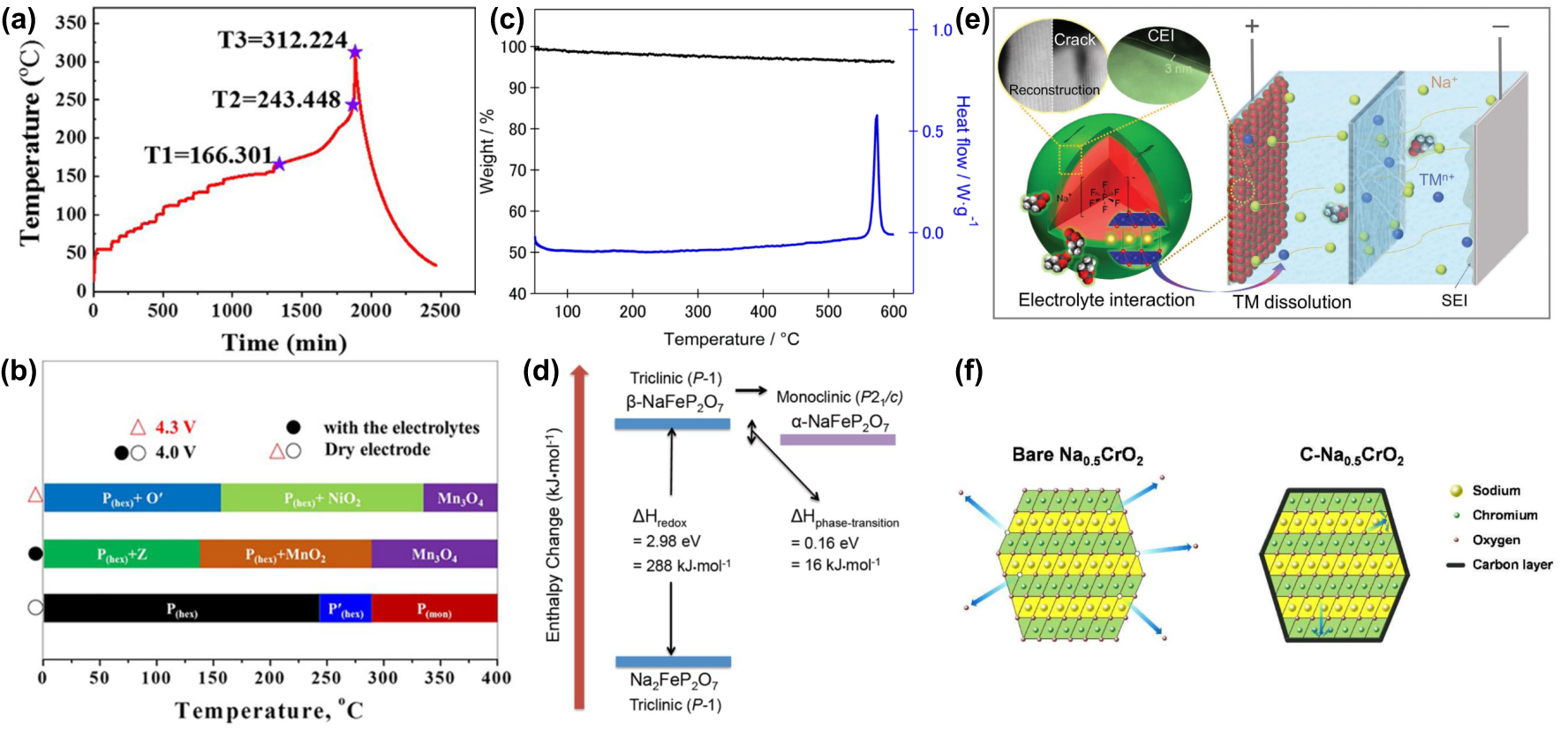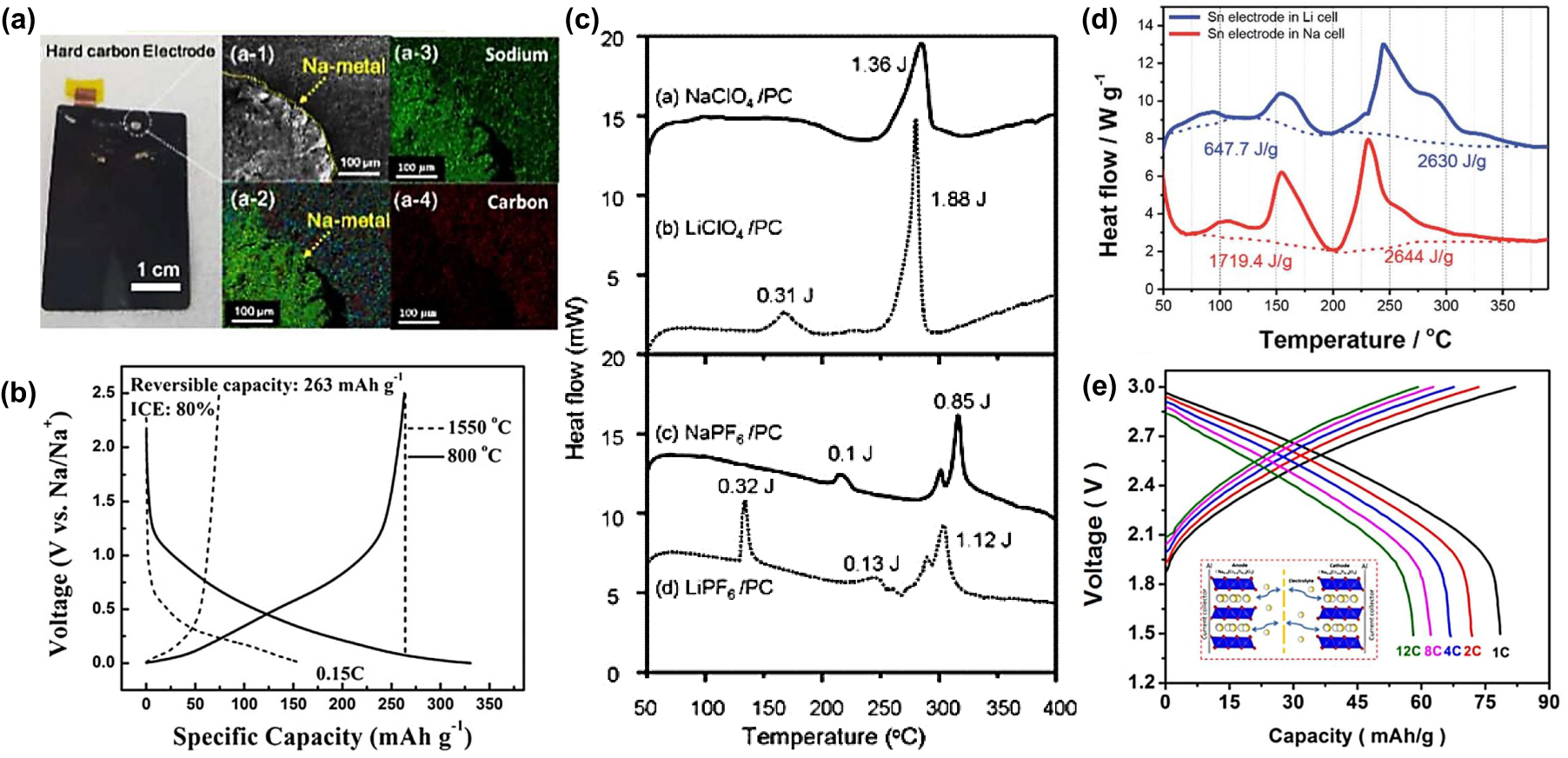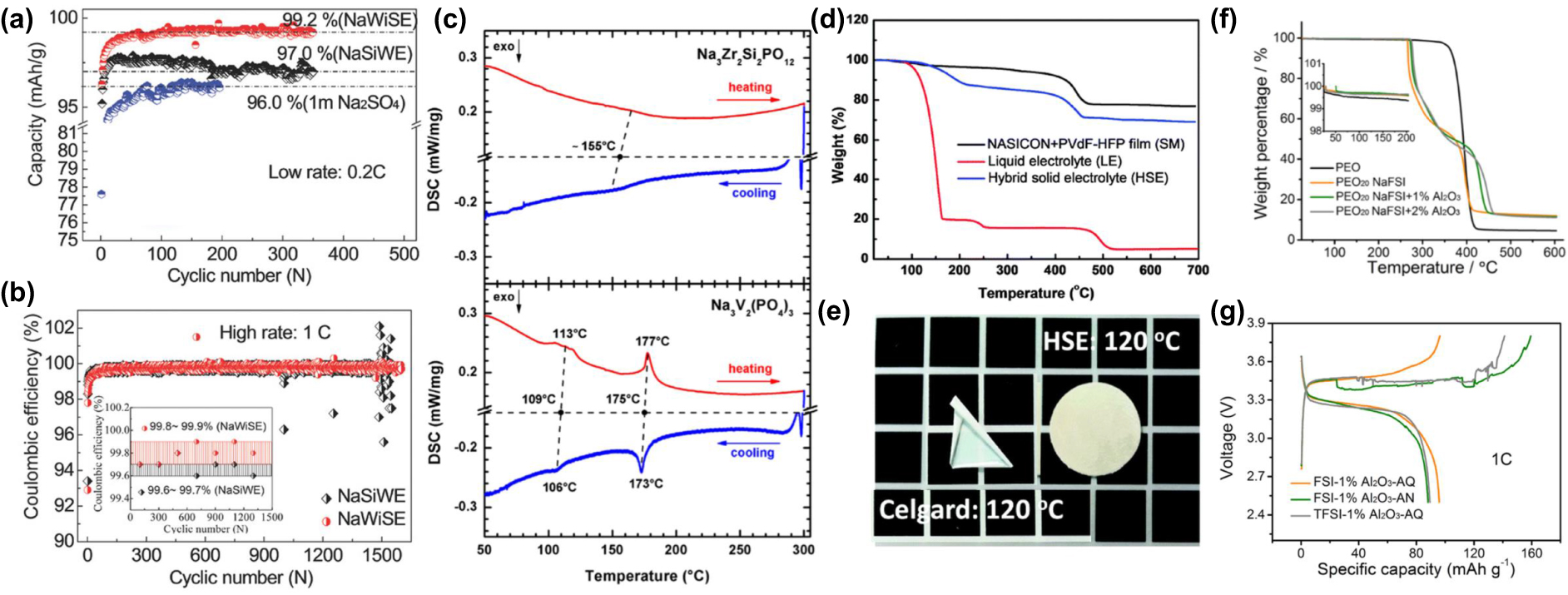† Corresponding author. E-mail:
Project supported by the National Key Technologies R&D Program, China (Grant No. 2016YFB0901500), the National Natural Science Foundation (NSFC) of China (Grant Nos. 51725206 and 51421002), NSFCUKRI EPSRC (Grant No. 51861165201), the Strategic Priority Research Program of the Chinese Academy of Sciences (Grant No. XDA21070500), Beijing Municipal Science and Technology Commission, China (Grant No. Z181100004718008), and Beijing Natural Science Fund-Haidian Original Innovation Joint Fund, China (Grant No. L182056).
Safety requirements stimulate Na-based batteries to evolve from high-temperature Na–S batteries to room-temperature Na-ion batteries (NIBs). Even so, NIBs may still cause thermal runaway due to the external unexpected accidents and internal high activity of electrodes or electrolytes, which has not been comprehensively summarized yet. In this review, we summarize the significant advances about the failure mechanisms and related strategies to build safer NIBs from the selection of electrodes, electrolytes and the construction of electrode/electrolyte interfaces. Considering the safety risk, the thermal behaviors are emphasized which will deepen the understanding of thermal stability of different NIBs and accelerate the exploitation of safe NIBs.
In order to satisfy the growing demand of grid energy storage systems, the development of low-cost and long-life batteries is being accelerated. Na-ion batteries (NIBs), almost simultaneously developed with mature Li-ion batteries (LIBs), are attractive alternatives to LIBs because the earth-abundant sodium element can work as the charge carrier in NIBs.[1–3] With the rapid development of electrode and electrolyte materials, the energy density of NIBs has experienced great improvement which was previously regarded as one of the main challenges for the practical application.[4–6] However, for stationary energy storage systems which are usually constructed in rural area with a long-running operation, the safety property is of the primary concern.
Throughout the history of Na-based batteries, sodium–sulfur and sodium–metal halide battery technologies have been demonstrated for the power station in the last century.[7] However, their operation temperature is relatively high (about 300 °C), let alone the metallic sodium also easily catches fire in wet conditions, which suggests a serious safety vulnerability. Thus, the potential explosion risk of these high-temperature Na-based batteries prompts the evolution towards the room-temperature stationary NIBs, which are based on rocking-chair battery design with Na+-host electrode materials. But the safety issue is easily overlooked and the challenges of building safer NIBs still exist. For example, compared with the Li+ case, the larger (Shannon effective ionic radius) and heavier Na+ suffers a poorer kinetics performance in host structures with insertion reaction mechanisms, thus the host matrix may degrade rapidly companied by an exothermic reaction. Besides, a higher solubility of the solid electrolyte interphase (SEI) was reported for NIBs due to the lower Lewis acidity of Na-complex, suggesting an incomplete protection of electrodes which may further induce the heat production.[8]
In this review, a summary about the failure and safety issue of NIBs is present considering new progresses achieved based on experimental results. We focus on strategies about how to build a safer NIB from the selection of electrodes and electrolytes. Moreover, the failure mechanisms of NIBs which are helpful to guide the safe battery design are discussed. Considering the main safety risk, the thermal behaviors (thermal stability) are emphasized, although electrochemical stability, mechanical stability, etc. are also important aspects for the failures of NIBs. Most importantly, we also include our own insights in this critical review.
Similar to the case of LIBs, the origin of the safety problems lies in thermal runaway induced by heat release inside the battery or external damage. As shown in Fig.
 | Fig. 1. (a) Three stages of the thermal runaway process.[9] (b)–(e) The safety test results of the prototype pouch cells (Na0.9[Cu0.22Fe0.30Mn0.48]O2//pyrolyzed anthracite) at fully charged state. The voltage and temperature evolutions in the processes of (b) external short-circuit test, (c) overcharge test, and (d) nail penetration test; (e) the photographs of pouch cells before and after safety tests.[10] |
A safe NIB needs to go through the strict safety assessments based on the simulation of the above conditions. The effective safety assessments include safety testing (overcharge/discharge, external short-circuit, high temperature aging, etc.) and abuse testing (crush tests, nail penetration, fire, etc.). Moreover, the analysis results of pouch cells are more credible than that of coin cells. Taking the 2 A⋅h pouch cell of Na0.9[Cu0.22Fe0.30Mn0.48]O2//pyrolyzed anthracite as an example, several tests are conducted on the fully charged pouch cells and the corresponding results are shown in Figs.
Intrinsic high safety is expected for electrodes of NIBs. For the cathode side, a stable crystal structure of cathode materials is vital as the decomposition of the active material at high voltage is a potential safety risk. The thermal stability of a typical layered cathode material NaNi1/3Fe1/3Mn1/3O2 was measured with accelerating rate calorimetry (ARC).[11] As shown in Fig.
 | Fig. 2. (a) Temperature vs. time plot of the charged NaNi1/3Fe1/3Mn1/3O2/hard carbon full cell under thermal stability testing with ARC. (b) Schematic representation summarizing thermal decomposition process of charged NaNi1/3Fe1/3Mn1/3O2 with different condition depending on the temperatures.[11] (c) Thermal analysis (TG-DSC) curves of the desodiated state NaFeP2O7 under steady Ar flow. (d) Enthalpy diagram of Na2–xFeP2O7 polymorphs.[14] (e) Schematic summary of cathode–electrolyte interfacial chemistry induced battery degradation mechanism.[15] (f) Thermal mechanism of de-sodiated Na0.5CrO2 at high temperature.[16] |
Besides the selection of intrinsic high safe cathodes related to the crystal structure, interfacial reaction and related surface tuning also need to pay attention to. Surface/interfacial reactions easily trigger heterogeneous surface reconstruction accompanied with transition metal reduction (dissolution) and surface oxygen loss, which indicate an unstable cathode–electrolyte interphase (CEI) with the possibility of CEI fracture during long-term cycling or high temperature operation, as shown in Fig.
As for the anode side, the safety problem is more serious because it suffers from the SEI instability and Na metal plating risk at low voltage. On the one hand, it is difficult to directly use Na metal as anode considering its high reactivity and risk of explosion (unless using some solid electrolytes or other safe electrolytes). On the other hand, even without Na metal as anode it is still possible that the deposition of metallic Na happens in the entire battery system due to unmatched mass ratio of anode and cathode materials as well as inappropriate operation like overcharge (Fig.
 | Fig. 3. (a) Digital photograph of hard carbon electrode collected from bare coated Na[Ni0.6Co0.2Mn0.2]O2/hard carbon full cell. (a-1) Scanning electron microscope (SEM) image and (a-2)–(a-4) corresponding energy dispersive x-ray spectroscopy mappings of the white circle region in (a).[18] (b) Comparison of the first discharge/charge curves of pitch-carbon-800 and pitch-carbon-1550 in half cells.[21] (c) DSC curves of 1 mg charged hard carbon electrode mixed with 2 ml EC/DMC (1 : 1 vol.%) solution containing 1 mol/dm3 NaClO4, LiClO4, NaPF6, or LiPF6.[23] (d) DSC profiles of the lithiated (using LiPF6 salt) and sodiated (using NaPF6 salt) tin electrodes after three cycles.[26] (e) Discharge profiles of Na0.6Cr0.6Ti0.4O2/Na0.6Cr0.6Ti0.4O2 sodium-ion full cell at various rates.[27] |
In addition, at elevated temperatures, the sodiated anode (charging state in full-cells) will undergo a more violent reaction with electrolyte compared to the cathode due to the poor thermal stability of SEI formed on the anode surface. Zhao et al. assessed the thermal behaviors of a typical hard carbon electrode working with carbonate electrolytes and made a comparison between LIBs and NIBs.[23] It was found that sodiated hard carbon exhibited less exothermic heat generation and higher onset decomposition temperature than lithiated hard carbon, indicating a better thermal stability of NIBs, as shown in Fig.
Recently, a novel symmetric battery design using the same materials for both cathode and anode with high safety and production convenience emerges. For example, Wang et al. designed a cation-disordered electrode Na0.6Cr0.6Ti0.4O2 with long sloping charge/discharge curves (Fig.
In traditional NIBs, the flammable organic liquid electrolyte is the “short board” of safety in the whole battery. Thus more consideration from the electrolyte side can greatly help to build a safer NIB. Most of the organic liquid electrolytes used in NIBs are referenced from LIBs. But Na salts usually show better thermal stability than Li salts due to higher electrostatic energy in ionic crystals of salts (Magdelung energy).[31] As for solvents, the cyclic solvent molecules exhibit higher onset decomposition temperature than that of linear one and co-solvents can reduce the heat release to some extent, as shown in Fig.
 | Fig. 4. (a) DSC heating curves up to 350 °C of solvents alone, solvent mixtures,propylene carbonate (PC) based electrolytes with 1 M of various Na salts, and ethylene carbonate (EC): diethyl carbonate (DEC) solvent mixture with or without a sodium salt (1 M NaClO4).[32] (b) TG curves of the NaPF6/PC electrolyte and the NaPF6/BMITFSI electrolytes range from room temperature to 600 °C.[36] (inset: the chemical structures of the cation and anion components of BMITFSI) (c) Left: Weight loss of laboratory-made NaFSA (NaFSI)/TMP electrolytes and conventional 1.0 M NaPF6/EC:DEC (1 : 1 vol.%) electrolyte in the thermogravimetric test. Right: flame tests of laboratory-made 3.3 M NaFSA/TMP electrolyte and conventional 1.0 M NaPF6/EC:DEC (1 : 1 vol.%) electrolyte.[39] (d) Schematic illustration of the SEI layer and possible mechanism for the decomposition of the TFEP-derived interlayer. (e) Cycling performance at 100 mA/g of the hard carbon/Na3V2(PO4)3 full cell.[41] |
In general, there is still a significant risk of flammability in organic liquid electrolyte which stimulates more development of new electrolyte systems including mainly aqueous and solid analogues, and both of them have their own characteristics. The aqueous system directly uses water as solvent with intrinsic safety and environmental friendliness but suffers a narrow electrochemical stability window (1.23 V).[45] Suo et al. improved the ratio of salt to water (so called “water in salt”) to enhance the operating window of NIBs (2.5 V) and the dynamics of electrode reaction is still superior with such high salt concentration, as shown in Figs.
 | Fig. 5. (a), (b) Electrochemical performances of Na0.66[Mn0.66Ti0.34]O2/NaTi2(PO4)3 full cell in different aqueous electrolytes (NaSiWE: 2 M NaCF3SO3, NaWiSE: 9.26 M NaCF3SO3, and 1 M Na2SO4). (a) Coulombic efficiency at low rate. (b) Cycle life at high rate.[46] (c) DSC data, recorded under Ar at 10 °C/min, of Na3Zr2Si2PO12 (top) and Na3V2(PO4)3 (down).[49] (d) TGA results for the composite solid film, ether-based liquid electrolyte (1 M NaCF3SO3/TEGDME), and NASICON-based composite hybrid solid electrolyte (HSE). (e) Shrinkage of commercial membrane (Celgard) and HSE at 120 °C.[50] (f), (g) Characterization of the neat PEO and as-prepared PEO20NaFSI + x wt.% Al2O3 (x = 0, 1, 2) blended polymer electrolyte: (f) TGA traces from 30 °C to 600 °C (the inset is an enlarged image from 30 °C to 200 °C); (g) typical charge and discharge curves of Na3V2(PO4)3 half-cells at the 1 C rate at 80 °C. (AQ: aqueous process; AN: acetonitrile as solvent).[51] |
With the industrialization of NIBs, the safety issues (especially, thermal stability) and related failure analysis are critical for their large-scale energy storage applications.[54] As summarized in Fig.
 | Fig. 6. (a) A summary of the exothermic onset temperatures about the different electrolytes and electrodes of NIBs which are related to thermal stability.[11,12,14,26,31,33,36,39,50,57] (b) Constant-volume-type DSC (using sealed gold-plated crucibles) profiles of 1 M NaPF6 in EC/DMC (1 : 1 vol.%) vs. 1 M LiPF6 in EC/DMC (1 : 1 vol.%). |
In the short term, NIBs with carbon anode and oxide cathode with organic liquid electrolyte have promising application prospect considering their cost and performance. Some recent reports have already demonstrated a high safety in pouch cells based on the above material system,[10] while the special safety mechanisms should be further clarified (high stable Al current collector and disordered carbon anode may be the key compared with the Cu current collector and graphite anode in Li-based system). Building stable SEI and CEI can further enhance the thermal stability. High safety phosphates, solid state electrolytes, salt-concentrated electrolytes, etc. are worth investigation in the future. Besides electrolytes and electrodes, the selection of separators, current collectors, and other components also has a deep influence on the safety of NIBs and the introduction of some smart materials including overcharge protection additives,[55] thermal responding reagents, etc. inspired from the design strategy of safe LIBs is necessary.[56]
In addition, accurate characterization methods need to be further developed to capture the detailed thermal parameters of NIBs. Very recently, we used a new constant-volume-type DSC (creating confined space to simulate closed battery environment) to make a comparison between the standard Li- and Na-based electrolytes. It is found that the Na-based system exhibits a better thermal stability than its Li counterpart from the less total heat generation or higher temperature of the exothermic peak of the Na-based system in Fig.
| [1] | |
| [2] | |
| [3] | |
| [4] | |
| [5] | |
| [6] | |
| [7] | |
| [8] | |
| [9] | |
| [10] | |
| [11] | |
| [12] | |
| [13] | |
| [14] | |
| [15] | |
| [16] | |
| [17] | |
| [18] | |
| [19] | |
| [20] | |
| [21] | |
| [22] | |
| [23] | |
| [24] | |
| [25] | |
| [26] | |
| [27] | |
| [28] | |
| [29] | |
| [30] | |
| [31] | |
| [32] | |
| [33] | |
| [34] | |
| [35] | |
| [36] | |
| [37] | |
| [38] | |
| [39] | |
| [40] | |
| [41] | |
| [42] | |
| [43] | |
| [44] | |
| [45] | |
| [46] | |
| [47] | |
| [48] | |
| [49] | |
| [50] | |
| [51] | |
| [52] | |
| [53] | |
| [54] | |
| [55] | |
| [56] | |
| [57] |

